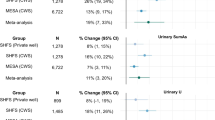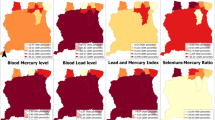Abstract
Biological monitoring of vanadium (V) and arsenic (As) for residents living near a big petrochemical complex has not been previously studied. This study aims to investigate distance-to-source trends in urinary levels and dispersion-estimated concentrations of V and As in areas surrounding a petrochemical complex in central Taiwan. Our study subjects were 1424 residents living in the townships up to ~40 km from the petrochemical complex, and categorized as near (Zone A), further (Zone B) and furthest (Zone C) from the complex. Urinary and ambient V and As levels were analyzed by inductively coupled plasma mass spectrometry. Two-stage dispersion model was used to estimate V and As concentrations at each study subject’s address. Multiple linear regression models were used to study the effects of distance-to-source and estimated air concentrations of V and As on the urinary V and As levels of study subjects. Area-wide levels of both V and As showed a high-to-low trend in urinary levels (μg/g-creatinine) from Zone A (V with 2.86±2.30 and As with 104.6±147.9) to Zone C (V with 0.73±0.72 and As with 73.8±90.8). For study subjects, urinary V and As levels were decreased by 0.09 and 1.17 μg/g-creatinine, respectively, with 1 km away from the emission source of the petrochemical complex, and urinary V levels were significantly elevated by 0.38 μg/g-creatinine with a 1 ng/m3 increase in estimated ambient V concentrations at their addresses. Our study concludes a distance-to-source gradient in V and As exposures exists for residents living near a petrochemical complex with oil refineries and coal-fired power plants and two-stage dispersion model can predict such a trend for V when inhalation is the major exposure route, but not for As that exposure may be from multiple sources and exposure routes.
This is a preview of subscription content, access via your institution
Access options
Subscribe to this journal
Receive 6 print issues and online access
$259.00 per year
only $43.17 per issue
Buy this article
- Purchase on Springer Link
- Instant access to full article PDF
Prices may be subject to local taxes which are calculated during checkout

Similar content being viewed by others
References
Agency for Toxic Substances and Disease Registry (Internet). Agency for Toxic Substances and Disease Registry, 2014, (cited 6 May 2014). Available on http://www.atsdr.cdc.gov/.
Fowler BA, Chou CHSJ, Jones RL, Chen CJ . Arsenic. In: Nordberg GF, Fowler BA, Nordberg M, Friberg LT (eds) Handbook on the Toxicology of Metals. Elsevier: London. 2007 pp 368–406.
Lagerkvist BJS, Oskarsson A . Vanadium. In: Nordberg GF, Fowler BA, Nordberg M, Friberg LT (eds) Handbook on the Toxicology of Metals. Elsevier: London. 2007 pp 906–924.
International Agency for research on Cancer (Internet). International Agency for Research on Cancer 2014 (cited 15 May 2014). Available on http://www.iarc.fr/.
Clancy HA, Sun H, Passantino L, Kluz T, Muñoz A, Zavadil J et al. Gene expression changes in human lung cells exposed to arsenic, chromium, nickel or vanadium indicate the first steps in cancer. Metallomics 2012; 4: 784–793.
Li Z, Stonehuerner J, Devlin RB, Huang YC . Discrimination of vanadium from zinc using gene profiling in human bronchial epithelial cells. Environ Health Perspect 2005; 113: 1747–1754.
Ress NB, Chou BJ, Renne RA, Dill JA, Miller RA, Roycroft JH et al. Carcinogenicity of inhaled vanadium pentoxide in F344/N rats and B6C3F1 mice. Toxicol Sci 2003; 74: 287–296.
Rondini EA, Walters DM, Bauer AK . Vanadium pentoxide induces pulmonary inflammation and tumor promotion in a strain-dependent manner. Part Fibre Toxicol 2010; 7: 9.
Burchiel SW, Mitchell LA, Lauer FT, Sun X, McDonald JD, Hudson LG . Immunotoxicity and biodistribution analysis of arsenic trioxide in C57Bl/6 mice following a 2-week inhalation exposure. Toxicol Appl Pharm 2009; 241: 253–259.
Ehrlich VA, Nersesyan AK, Atefie K, Hoelzl C, Ferk F, Bichler J et al. Inhalative exposure to vanadium pentoxide causes DNA damage in workers: results of a multiple end point study. Environ Health Perspect 2008; 116: 1689–1693.
Yoshikawa M, Aoki K, Ebine N, Kusunoki M, Okamoto A . Correlation between the arsenic concentrations in the air and the SMR of lung cancer. Environ Health Prev Med 2008; 13: 207–218.
Alleman LY, Lamaison L, Perdrix E, Robache A, Galloo JC . PM10 metal concentrations and source identification using positive matrix factorization and wind sectoring in a French industrial zone. Atmos Res 2010; 96: 612–625.
Fernández-Camacho R, Rodrígueza S, de la Rosa J, Sánchez de la Campa AM, Alastuey A, Querol X et al. Ultrafine particle and fine trace metal (As, Cd, Cu, Pb and Zn) pollution episodes induced by industrial emissions in Huelva, SW Spain. Atmos Environ 2012; 61: 507–517.
United States Environmental Protection Administration. Protocol for applying and validating the CMB model for PM2.5 and VOC. United States Environmental Protection Administration, USA, 2004.
Nadal M, Mari M, Schuhmacher M, Domingo JL . Multi-compartmental environmental surveillance of a petrochemical area: levels of micropollutants. Environ Int 2009; 35: 227–235.
Nadal M, Schuhmacher M, Domingo JL . Metal pollution of soils and vegetation in an area with petrochemical industry. Sci Total Environ 2004; 321: 59–69.
Jayasekher T . Aerosols near by a coal fired thermal power plant: chemical composition and toxic evaluation. Chemosphere 2009; 75: 1525–1530.
Keegan TJ, Farago ME, Thornton I, Hong B, Colvile RN, Pesch B et al. Dispersion of As and selected heavy metals around a coal-burning power station in central Slovakia. Sci Total Environ 2006; 358: 61–71.
Aguilera I, Daponte A, Gil F, Hernandez AF, Godoy P, Pla A et al. Biomonitoring of urinary metals in a population living in the vicinity of industrial sources: a comparison with the general population of Andalusia, Spain. Sci Total Environ 2008; 407: 669–678.
Aguilera I, Daponte A, Gil F, Hernandez AF, Godoy P, Pla A et al. Urinary levels of arsenic and heavy metals in children and adolescents living in the industrialised area of Ria of Huelva (SW Spain). Environ Int 2010; 36: 563–569.
Yunlin County Environmental Protection Bureau Risk assessment on air pollution and health among residents near a petrochemical complex in Yunlin County (Final Report). Yunlin County Environmental Protection Bureau: Taiwan. 2009.
Yunlin County Environmental Protection Bureau Air pollution and health among residents near a petrochemical complex in Yunlin County: a cohort study (Final Report). Yunlin County Environmental Protection Bureau: Taiwan. 2012.
Formosa Petrochemical Corporation. No. 6 Naphtha Project (Internet). Formosa Petrochemical Corporation, 2014, (cited 20 May 2014). Available on http://www.fpc.com.tw/j21c/cus/mlp/Cclm01.do.
Taiwan Environmental Protection Administration Taiwan Emission Data System 7.0. Environmental Protection Administration: Taipei, Taiwan, ROC. 2007.
Google Inc. Google Earth Version 7.1.2.2041, 2013, (cited 20 May 2014) Available on http://www.google.com/earth/index.html.
QGIS Development Team. QGIS Geographic Information System. Open Source Geospatial Foundation Project, 2013, (cited 20 May 2014). Available on http://qgis.osgeo.org.
Geological Survey (US) The Universal Transverse Mercator (UTM) Grid. Reston, Va. US Dept. of the Interior, US Geological Survey, 2011, (cited 20 May 2014). Available on http://pubs.er.usgs.gov/publication/fs07701.
Chio CP, Yuan TH, Shie RH, Chan CC . Assessing vanadium and arsenic exposure of people living near a petrochemical complex with two-stage dispersion models. J Hazard Mater 2014; 271: 98–107.
Hope BK . An assessment of the global impact of anthropogenic vanadium. Biogeochemistry 1997; 37: 1–13.
Heitland P, Köster HD . Biomonitoring of 30 trace elements in urine of children and adults by ICP-MS. Clinica Chimica Acta 2006; 365: 310–318.
Mukherjee S, Rodrigues E, Aeschliman DB, Houk RS, Palmer LJ, Woodin MA et al. Urinary metal and polycyclic aromatic hydrocarbon biomarkers in boilermakers exposed to metal fume and residual oil fly ash. Am J Ind Med 2005; 47: 484–493.
Chritensen JM . Human exposure to toxic metals: factors influencing interpretation of biomonitoring results. Sci Total Environ 1995; 166: 89–135.
Clark NA, Teschke K, Rideout K, Copes R . Trace element levels in adults from the west coast of Canada and associations with age, gender, diet, activities, and levels of other trace elements. Chemosphere 2007; 70: 155–164.
Seiwert M, Conrad A, Becker K, Hunken A, Schulz C, Kolossa-Gehring M . The German environmental survey for children (GerES IV): socio-economic status and exposure to pollutants. Epidemiology 2008; 19: S250.
Acknowledgements
We thank the financial support provided by the Environmental Protection Bureau, Yunlin County, Taiwan (Project: YLEPB-98-016, YLEPB-99-022 and YLEPB-100-029).
Author information
Authors and Affiliations
Corresponding author
Ethics declarations
Competing interests
The authors declare no conflict of interest
Rights and permissions
About this article
Cite this article
Yuan, TH., Chio, CP., Shie, RH. et al. The distance-to-source trend in vanadium and arsenic exposures for residents living near a petrochemical complex. J Expo Sci Environ Epidemiol 26, 270–276 (2016). https://doi.org/10.1038/jes.2015.2
Received:
Revised:
Accepted:
Published:
Issue Date:
DOI: https://doi.org/10.1038/jes.2015.2
Keywords
This article is cited by
-
Arsenic exposure was associated with lung fibrotic changes in individuals living near a petrochemical complex
Environmental Science and Pollution Research (2023)
-
Assessment of the hyperlipidemia risk for residents exposed to potential emitted metals in the vicinity of a petrochemical complex
Environmental Science and Pollution Research (2021)
-
Associations of soluble metals and lung and liver toxicity in mice induced by fine particulate matter originating from a petrochemical complex
Environmental Science and Pollution Research (2020)
-
Levels and temporal variations of urinary lead, cadmium, cobalt, and copper exposure in the general population of Taiwan
Environmental Science and Pollution Research (2019)
-
Health risk assessment of volatile organic compounds exposure near Daegu dyeing industrial complex in South Korea
BMC Public Health (2018)



